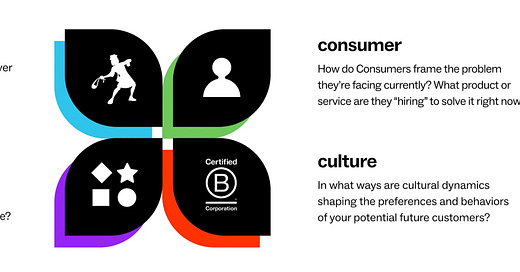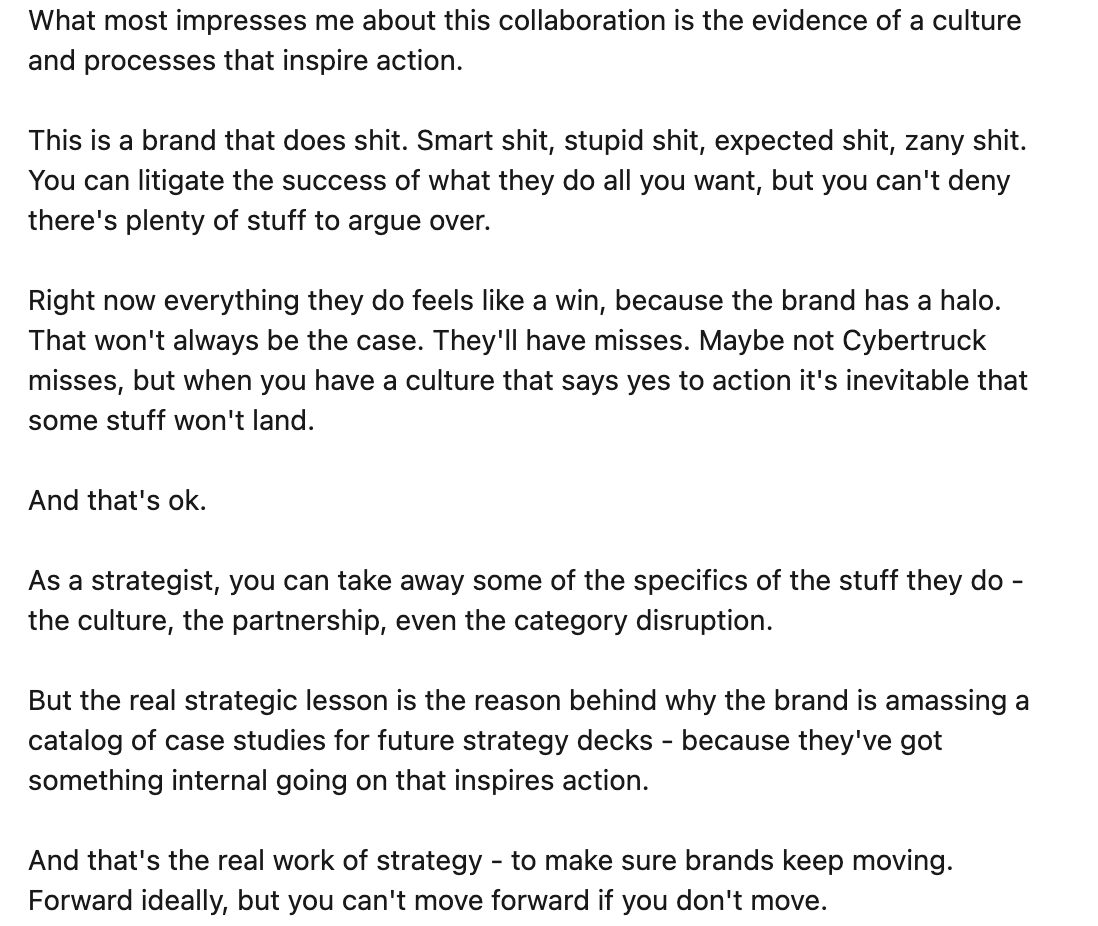Your 4-Cs framework is 1 C too many
And at least one other opinion likely to get me canceled by the agencysphere.
Hello-
I’ve managed to go all week without having a hot take on the Apple iPad Pro ad! I hope your week has been equally peaceful and productive.
Instead, here’s what I’ve been thinking about:
That 4-Cs framework strategy minds like to throw around as the cornerstone of planning? You can be a better strategist if you only use 3 of the Cs.
Liquid Death has done a new thing which I hate, and which I also still applaud (well, golf clap).
How do you change the behavior around gender norms of a 150 year old luxury brand? With a clear and obvious insight.
I’m normally not confrontational by nature, but each of the ideas in this week’s newsletter could make third of my audience want to fight me. Read on to see which third you’re in.
The 4-Cs framework is 1 C too many
Most strategists are introduced to the 4Cs framework at some point (early) in their careers. It’s immensely popular as a way of organizing the thoughts, inputs and ideas that ultimately shape a strategy. The Cs are:
Company: what’s unique about the brand / business
Category: sometimes referred to as “Competition,” this is really the arena of choice for the brand’s customers
Consumer: Alternatively “Customer,” this aims to unveil needs, motivations, values and other kinetic or latent drivers of decision-making
Culture: What’s happening in the world that’s shaping perceptions, preferences and priorities
A good strategy ostensibly derives insights from all of these. This ensures that the idea is:
Credible: something the company can actually do - capably and believably (the C for “Company”)
Distinctive: so that it stands out from alternatives (“Category”)
Desirable: selling a thing nobody else is selling doesn’t matter if nobody wants it (“Customer”)
Relevant: the idea connects with customers in ways that are meaningful to them
What if I told you that you can build strategies that are quicker to create, simpler to convey, easier to understand, and better suited to their task by using only 3 of the Cs?
You don’t need Culture. I realize that’s heresy in some strategy circles. But here’s why I don’t use it:
If there are insights around culture that are relevant to your customers, they’ll show up in your Customer research. If culture is important to your brand, it’ll show up in your Company research. Likewise in Category - if there are cultural movements shaping the competitive environment, you’ll find them there.
If you insist on including culture, you may risk shoehorning something into the strategy that doesn’t make the idea stronger or the strategy clearer. It can even weaken an idea by narrowing it - by audience or by time. Not every good idea is cultural.
I’ll give you an example. Old Spice’s “The Man Your Man Could Smell Like” was one of the most popular campaigns ever, and even became a cultural phenomenon itself. But the insight the campaign hung on was that 60% of body wash purchases are made by women. That’s a category insight, not cultural.
And I’ll give you another example on the other side - what happens when you try to force culture where it doesn’t belong. You can get an ad like Pepsi’s infamous “Live for Now” with Kendall Jenner, panned as perhaps the worst advertisement of all time.
Think also of all the ads where a cultural element is visible (and not disastrous). For example, I don’t know why VW landed on Darth Vader for its ad. The strategist could have used the fourth C to intentionally tie the brand to pop culture. Or they could have realized - when researching what was interesting to the brand’s C-Customers - that Star Wars indexed high. You could get to the same ad either way.
Instead of expressly looking for the cultural input that you need to include, just keep your antennae up for cultural inputs as you go through your research across your other Cs. If they matter, you’ll pick them up. And if they don’t matter you may still pick them up. But if they don’t have their own category that you’re pressing into the strategy, you can simply regard them and elect to discard them. You can’t do that if you have a Culture box to check.
And you end up with a strategy with fewer ingredients. That’s fewer slides to make and present, and fewer pieces to help the client stitch together to follow your narrative.
The 3-Cs. Simplify. That’s the job of strategy after all.
Right brain
Matinee
Today the part
of love will be played
by regret. Memory
will be played
by what if, tragedy
by the saxophonist.
Silence will be played
by silence. There will
be no intermission.
-Andrea Cohen
Liquid Death’s new Adventures of Murder Man show trailer is both awful and commendable
Liquid Death released a trailer for a show called The Adventures of Murder Man. Predictably, the agencysphere loves it. The obsequious fawning in the comments on YouTube are just the tip of the iceberg. The rabid endorsement climbs an even higher pitch on LinkedIn.
I don’t know if this is an actual trailer for a show the brand is shopping around or just a stunt. But whatever it is, it’s unfunny, awkwardly self-serving, and cringey. It feels like the text I sent to my teenage daughter last night where I told her I hoped I wasn’t being too cheugy (I had to look up “gen z slang for uncool”).
But as much as I personally find nothing redeeming in the video, professionally I have to commend it. I said a few weeks ago at the Liquid Death / e.l.f. collab that the brand is an example of a superior strategic environment because something in their culture or process is driving action.
So good on them for doing more stuff, even if I hate it. Both the content and the quantity of content are on brand.
(House ad)
The 90-Minute Full-Day Team Workshop
I’ve been getting requests for team training. It’s not what I do (it’s kind of the OPPOSITE of what I do as a 1:1 coach). But I listen to the market and worked with a client to develop The 90-Minute Full-Day Team Workshop. It’s now available to you too.
A full day of strategy coaching? Sounds great, except for the part where your entire strategy team needs to ignore their clients, PMs and deliverables for a full day. What if I told you that because strategy coaching is 1:1, a full day of coaching only requires 90 minutes from each strategist? We’ll do a group thing in the morning to orient, and then I spend the rest of the day individually with each strategist, coaching and collaborating. There’s more on the website, or just reply to this email.
More women are buying Tag Heuer watches. So why is the brand’s response to deprioritize women’s watches?
Tag Heuer is seeing women comprise a growing % of their customers. Which they want to encourage. So why are they deprioritizing women's watches? Because of an insight of course.
According to CMO George Ciz, "The smaller wrist is an important part of our strategy because we don’t necessarily reference it as men or women, we really think about wrist sizes ... What we’re seeing is some ladies prefer bigger watches and some men prefer a bit smaller watches."
Seems self-evident, right? That people buy watches because of how they look on their wrists. It should be obvious - the best insights are. They're often just hidden in plain sight. They hit hard not because they're new information - but for exactly the opposite reason. They've been there all along.
But decades of doing anything a certain way builds up a lot of inertia. Knowing how to find an insight from customer behavior is an essential skill for a strategist. Knowing how to use it to persuade requires knowing your client as well as your customer.
CMO Giz hints that the brand is moving away from gender not just in the way watches are merchandised, but even in the way they're conceived and brought to market - thinking more about watches as unisex, but in different sizes.
"We try to think more progressively and we believe we live in a different world and I think it’s less about men versus women, it’s more about unisex styles, the right sizes for the right wrist and the right storytelling that people want with the right inspiration that we want to deliver to our clients."
Again, seems self-evident based on the insight. But the greater job of strategy isn't find the insight - it's to find away for it to drive action. Not an easy feat at a 150 year old luxury brand.
Signal boost
If you’re an advertising person and you haven’t discovered Robert Mayhew’s TikTok yet, be prepared to be seen. (Full disclosure: I found him on LinkedIn where you can also follow him.)
I learned the word Smallwashing this week from the Fritinancy substack. It’s where brands pretend to be, well, small.
This Chinese Restaurant in London is making some of the best social advertising you’ve seen all year.
Have something for a future Signal Boost? Email me or just reply to this newsletter.
Thanks for reading all these words and subscribing (to even more words). If you know any other strategists or strategy-adjacent folks who might like this newsletter that button is for you.
About The Strategy Coach Company
I’m Mike May and I founded the Strategy Coach Company to help brand and agency strategists get better at their job while doing their job. I provide 1:1 coaching, collaboration, real-time feedback and thought partnership on actual work in progress, because I know that’s the best way to get better at doing strategy, and at being a strategist. You can learn more at StrategyCoach.co, connect with me on LinkedIn, or just reply to this newsletter.










